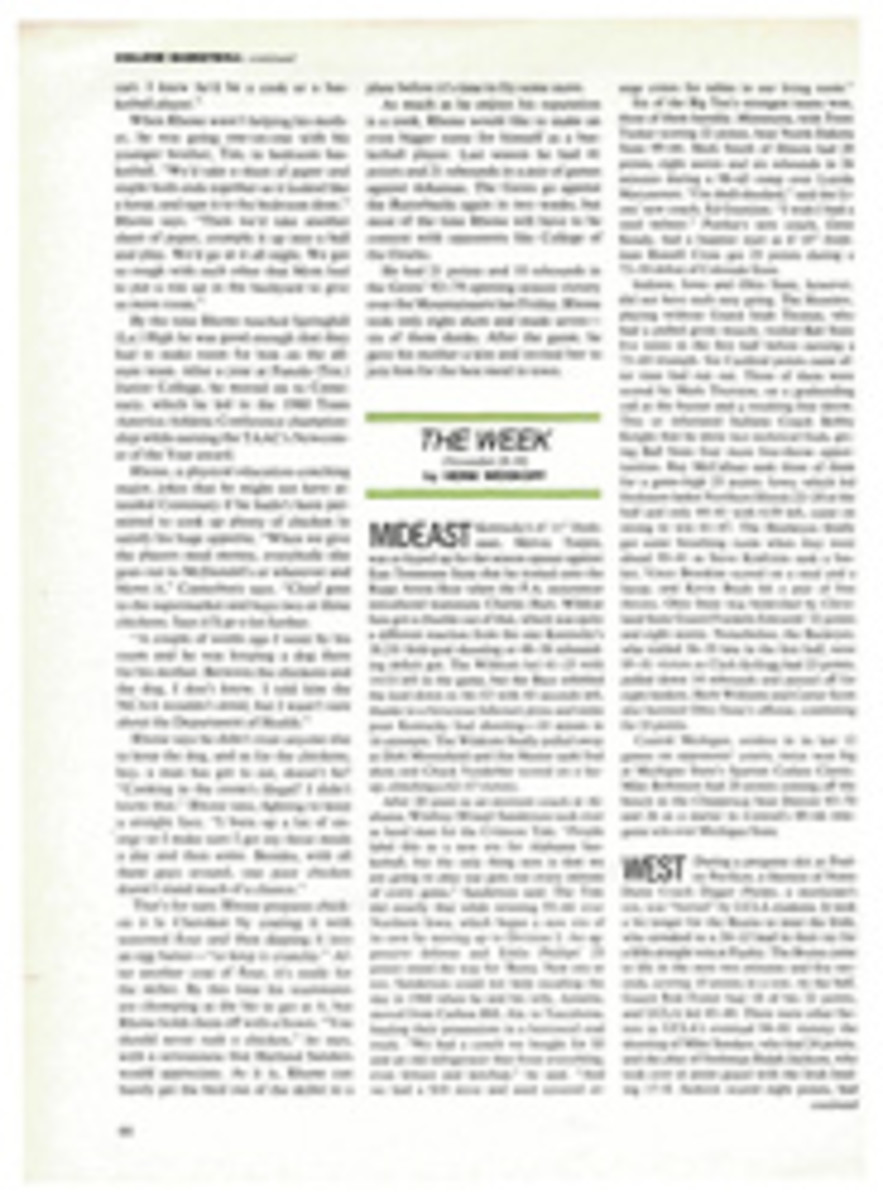
THE LEAD-SHOT DISPUTE, OR WHY THE FEDS SHOULD RUN THE GAME—AND FISH
Research concerning the poisoning of waterfowl by lead shot has been conducted by conservationists, ammunition manufacturers and state fish and game departments throughout most of this century. Briefly described, here's the problem: It's estimated that American hunters deposit 3,000 tons of lead pellets annually in lakes, ponds and marshes across the country. In waterfowl habitat where the soil is relatively hard and the water shallow, birds invariably ingest these pellets while feeding. It is believed that in the U.S. at least 6% of the waterfowl ingest at least one lead pellet each year. The mortality rate from lead poisoning is thought to be 2% to 3% of the fall population of all species, and that means that between 1.6 and 2.4 million ducks die each year.
The search for a non-toxic substitute for lead has been going on for more than 30 years. The many materials tested have included lead with non-metallic coatings, lead coated with various non-lead alloys, lead alloyed with other metals, water soluble lead, lead-glass beads and lead-iron shot. But each of these was found to have a toxicity equal to or greater than that of lead, and it became clear that steel would be the only suitable substitute.
Finally, on March 20, 1976, Secretary of the Interior Thomas Kleppe announced a plan for the progressive implementation of rules stipulating the use of steel shot. It was to be required at designated areas of the Atlantic Fly-way in 1976, in areas of the Mississippi Fly-way in 1977 and in areas of the Central and Pacific flyways in 1978.
It all sounded reasonable enough on paper. But hunters immediately began to complain. Their objections were that steel shot costs more, that the harder steel shot would ruin the barrels of their shotguns and that steel shot isn't as efficient as lead and would result in fewer birds bagged and more birds crippled.
There's some truth in the first of these claims. Steel-shot shells can cost as much as 50% more than lead-shot shells, but for the average duck hunter, the extra amount spent on steel-shot shells would increase his total annual expenditures on the sport by only 4%. Besides, the price of lead is rising faster than the price of steel and the technology of manufacturing steel shot is still new, so it's reasonable to assume that in a few years steel shot will become economically competitive and as equally available as lead shot.
According to every study I've seen—and I think I've seen 'em all, dozens of them over the years—the other complaints so often made by hunters have been found to have no substance.
Most early research comparing the crippling rates of steel and lead shot was conducted in laboratories or took the form of semi-controlled field studies. Recent studies have been undertaken under actual hunting conditions and have substantiated the findings of the earlier tests—that there's no significant difference in the crippling rates of lead and steel. If anything, tests prove that steel is actually more efficient. Despite this, hunters persist in their prejudice against steel. In a 1978 study conducted at the Tule Lake National Wildlife Refuge in California, hunters made negative comments about shells they used that they thought held steel shot, when in fact the shells held lead. And they praised shot that they'd been told was lead—but was actually steel.
The arms and ammunition industry has studied the effects of the harder steel shot on gun barrels and concluded that modern American-made single-barrel shotguns with full chokes, the type of guns used by the majority of duck hunters, showed no damage from steel shot that would have any measurable effect on performance.
One might reasonably think that when a sufficient number of hunters had been made aware of the above facts, the steel-shot regulations would've gained popular acceptance, been implemented on a broader scale and finally accomplished what they were designed to do. Unfortunately, this hasn't been the case, because state politics, not concern for poisoned ducks, became the primary consideration in the lead-steel dispute.
For decades, conservationists and thoughtful sportsmen have worked hard to get politics out of wildlife management decisions that should be based on a knowledge of ecology and the environment. That they haven't succeeded is clear enough when it comes to the federal steel-shot regulations. As the rules were expanded to encompass more westerly fly ways in 1977 and 1978, some states objected. In addition to the arguments already cited, they claimed that birds weren't dying from lead poisoning, that the Federal Government wasn't responsive to state biological data and that, therefore, steel-shot areas were being designated haphazardly. Because of the complaints by the states, the Senate added what has become known as the Stevens Amendment to its 1979 Interior's appropriations bill. This amendment effectively took the authority to enforce steel-shot regulations away from the Federal Government and gave it to the states.
What happened in Louisiana, and may occur in other states as well, demonstrates the danger in this. There a game commission of political appointees has rejected the recommendations of its staff of professional biologists and has asked that steel-shot zones be eliminated within the state—despite the fact that for a variety of reasons ducks in Louisiana are more likely to ingest lead shot than those in most other areas of the U.S. So far, two of the 36 states still affected by steel-shot regulations—Maryland and Nevada—have decided not to approve their implementation.
The controversy over the steel-shot regulation is a complex one, but it can be reduced to basics for the purpose of making a single and very crucial point—wildlife resources are too valuable and too fragile to be left to politicians. Usually the top priority of politicians is getting votes, not conserving wildlife. In states where wildlife is abundant, there tend to be many outdoorsmen, too. Hunters and fishermen are voters, so politicians will usually court their favor.
And sportsmen aren't the only ones putting pressure on game commissioners. If, say, an attempt is made in a western state to shorten the hunting season, farmers and timber companies will complain that deer and elk will eat their crops and trees. Commercial fishermen are interested in their share of the salmon run, and no one else's. If a game commission tried to create a fly-fishing-only zone on a river, the motel and sporting-goods store owners in the vicinity would complain bitterly that their businesses would suffer.
On a larger scale activities in Alaska are instructive. The Federal Government has attempted to designate vast tracts of land in that state as protected wilderness. The Feds were met with fanatical opposition from state politicians who, of course, were merely representing the special interests of the various groups that they serve. Last month the House finally passed the bill already passed by the Senate, which designates 104 million acres of Federal land for parks, wildlife refuges and forest and wild river preservation.
Typically, a governor appoints fish and game commissioners he hopes will please the voters. Appointments are often made as repayment for past political favors. If a commissioner strays too far in the name of conservation—by, say, trying to reduce bag limits or shorten a season—voters will complain, the commissioner will be pressured to change his mind, and he very likely won't be reappointed when his term expires.
An example of the process at work is the case of Louisa Bateman, who resigned from the Oregon Wildlife Commission in the late summer of 1979 after serving for six years. Originally appointed by former Governor Tom McCall, she was well-known throughout the state as a conservationist. When she attempted to shorten the Columbia River commercial gill-netting season for salmon, as others had tried to do, the all too predictable result was that opposition with direct connections to commercial fishing interests worked against her reappointment at the completion of her term. Their efforts failed because Batemen beat them to the punch and quit out of sheer frustration. "At least half the decisions made and policies implemented by the commission were political in one way or another." she says. "And I just got sick of it. I couldn't take it anymore." (It should be added that Bateman lives near Klamath Marsh, a well-known waterfowl hunting area, and she often finds lead shot in the gizzards of the ducks she cleans. She is definitely in favor of steel-shot regulations.)
The benefits of federal control over wildlife resources can be demonstrated by a brief look at Yellowstone National Park. Back in the 1950s, fly-fishing-only rules on the Madison River and severely reduced bag limits on most of the park's waters were imposed. These were restrictions that would never have been put into effect by a state government if the Feds hadn't tried them out first—in fact, until recently nothing like them had been implemented in any state, even though as a result of the rules Yellowstone today contains the finest trout fishing in America.
Jack Anderson, who was superintendent of Yellowstone in the late 1960s, was largely responsible for enforcing the regulations that have done so much to enhance the fishing there. He is pleased to note that after all these years Montana is now working to make fishing regulations outside the park, particularly as they apply to the Madison River, similar to those in force within the park for decades. "I'm sure that what we did in the park—the example we created—has a lot to do with what the state is doing now," Anderson says. "They hired a first-rate biologist and he's accomplished plenty. Everybody will be better off for it in the long run."
So, though there may be many compelling arguments for states' rights, they don't apply to wildlife management. In September Thomas Kimball, executive vice president of the National Wildlife Federation, spoke to a Senate subcommittee that was considering the steel-shot situation. "The steel-shot rider to the appropriations bill [the Stevens Amendment] has done much more than give the states a greater say in waterfowl regulations," Kimball said. "By far its most detrimental and dangerous impact is the encouragement of wildlife management by politics."
Michael E. Berger, assistant director of the Resources Defense Division of the National Wildlife Federation, puts it this way, "One might ask: Who gains through this controversy? Certainly not the waterfowl resource, for it continues to be poisoned as before in those states that reject the regulations. Certainly not the waterfowl hunter whose hunting opportunities may be reduced as a result and who may be portrayed as an individual who cares more about a small increase in the cost of ammunition than the well-being of birds he hunts and must maintain. Maybe the winners are the politicians."

